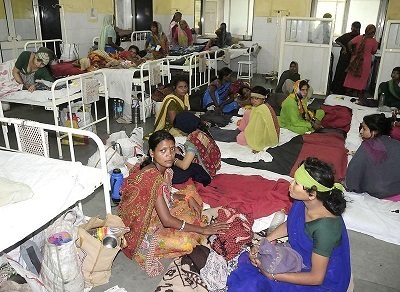Context-
India's health sector faces significant challenges, with low public spending leading to high out-of-pocket expenses for households. Despite the dire situation, health remains a non-issue in political elections and the Budget.
Current State of Health Spending
- Public Health Spending : India's goal of raising public health spending to 2.5% of GDP remains elusive. Currently, total health spending is about 3.5% of GDP, with public health spending accounting for approximately 1.35%. This low public investment translates into high out-of-pocket expenditures for households, exacerbating financial burdens, especially for those already living at the margin.
- Impact of Economic Shocks : Demonetisation, the implementation of the Goods and Services Tax (GST), and the COVID-19 pandemic have significantly impacted households. Many have faced stagnant wages, high food prices, and increased borrowing, making healthcare unaffordable for a significant portion of the population. In rural areas, 13.4% of households borrowed money to pay medical bills, while in urban areas, the figure was 8.5%. The rest either sought free public care, denied themselves healthcare, or opted for substandard care within their budget.
Poverty and Healthcare
- Falling Below the Poverty Line : An estimated 60-80 million households have fallen below the poverty line due to medical expenses. Despite these alarming figures, health remains a non-issue in Indian elections. The country's health system is at a crossroads, needing to build capacity, particularly in northern states, to manage the dual burden of communicable and non-communicable diseases.
- Disease Management : Communicable diseases, being episodic, are relatively easier to handle. However, neglect can lead to devastating consequences. Non-communicable diseases require lifetime management, necessitating a steady and routinized system of care. Balancing these needs requires a health system that is both swift and steady, with the right mix of skills, technology, infrastructure, and supervisory systems. All of this requires substantial funding.
Health System Reforms
|
What are the Recent Government Initiatives Related to Healthcare? ● National Health Mission ● Ayushman Bharat ● Pradhan Mantri Jan Arogya Yojana (AB-PMJAY) ● National Medical Commission ● PM National Dialysis Programme ● Janani Shishu Suraksha Karyakram (JSSK) ● Rashtriya Bal Swasthya Karyakram (RBSK) |
- Ineffective Reforms : Unlike many countries that have reformed their health systems, India has wasted time with inadequate budget increases and reactive measures to health crises. One example is the incremental increase in the sum assured under subsidized social health insurance, which fails to address the systemic issues in healthcare.
- Budget Expectations : Despite past disappointments, there are high expectations for the upcoming budget. Since 2010, India's public health spending as a proportion of GDP has hovered between 1.12% and 1.35%. Although central budget allocations have increased—from ₹25,133 crore in 2012-13 to ₹86,175 crore in 2023-24—the proportion of the central health budget to GDP has remained around 0.27%. State spending averages 5% of their revenue budgets, falling short of the targeted 8%. This is particularly low in poorer states like Bihar.
What Should be the Way Forward for the Budget?
- Implement NITI Aayog Action Plan for Health : Focus on enhancing public health by significantly increasing government expenditure to 2.5% of GDP and prioritizing preventive care over curative care.
- Establish the National Commission for Healthcare Cost Management : Appoint a national commission to recommend healthcare spending strategies and monitor system performance.
- World Bank and ADB Loans : A positive development is the recent negotiation of loans totaling $240 million from the World Bank and the Asian Development Bank (ADB). These loans aim to strengthen district-level disease surveillance laboratories, establish ICUs in large districts, and enhance primary healthcare facilities. While these loans address some gaps highlighted by the COVID-19 pandemic, India must continue to invest heavily and swiftly in building basic health infrastructure, especially in states with significant shortfalls.
- Disparities in Health Infrastructure : States such as Bihar, Uttar Pradesh, Madhya Pradesh, Odisha, Rajasthan, Chhattisgarh, Jharkhand, and Assam face a severe shortage of health facilities and human resources. These disparities need to be bridged with a substantially increased and differential funding package from the central government.
- Ayushman Bharat : Until the supply of healthcare services improves, demand-side interventions like Ayushman Bharat (PMJAY) offer limited value, particularly since outpatient care is not covered. To develop systems in lagging states, the Finance Ministry must significantly increase health budgets, particularly for the National Health Mission (NHM), and allocate all funds collected under the 4% health cess to the health budget. Of the ₹69,063 crore collected so far, only 25% has been transferred to the Health Ministry.
- Rationalizing GST Levies : In addition to bolstering public health systems, there is a need to rationalize GST levies on health products. For instance, an 18% GST on health insurance premiums and a 5% GST on insulin and hepatitis diagnostics are problematic given the increasing prevalence of diabetes and hepatitis. Disincentives should be considered for private entities that increase healthcare costs despite full GST exemptions and other financial benefits.
- Public Health as a Right : The core issue in the health sector is the role of the state, the rights of tax-paying citizens, and the proposed development model. Key questions include whether health is a public good, if healthy well-being is foundational for human development, and if health is part of the social contract between citizens and the state. If the answer to these questions is affirmative, the government must double the health budget and initiate reforms to fix the dysfunctional system.
Conclusion
Setting right the health system requires time, political consensus, and stability. Other countries have shown the way, and India must follow their path to achieve its aspiration of becoming a developed country by 2047. A substantial increase in the health budget, alongside systemic reforms, is crucial to ensure that healthcare is accessible and affordable for all citizens.
|
Probable Questions for UPSC Mains Exams-
|
Source - hindu







